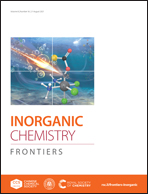Systematic centricity control using a chiral template: novel noncentrosymmetric polar niobium oxyfluorides and tantalum fluorides directed by chiral histidinium cations, [(l-hisH2)NbOF5], [(d-hisH2)NbOF5], [(l-hisH2)TaF7], and [(d-hisH2)TaF7]†
Abstract
Enantiomorphic histidinium cation-driven niobium and tantalum (oxy)fluoride compounds have been systematically synthesized through a slow evaporation method. Single-crystal X-ray diffraction indicates that all four reported chiral materials crystallize in the noncentrosymmetric polar space group, P21. While [NbOF5]2− distorted octahedra are templated by enantiopure histidinium cations in [(L-hisH2)NbOF5] (L-Nb) and [(D-hisH2)NbOF5] (D-Nb), monocapped trigonal prismatic [TaF7]2− units are aligned by the acidified amino acid cations in [(L-hisH2)TaF7] (L-Ta) and [(D-hisH2)TaF7] (D-Ta). The frameworks of the title compounds exhibit thermal stability up to ca. 180 °C. While the band gaps of L-Nb and D-Nb were found to be ca. 4.45 and 4.47 eV, respectively, those of L-Ta and D-Ta turned out to be higher, with values of 5.07 and 5.06 eV, respectively. Clearly reversed signals observed in the solid-state circular dichroism spectra confirm the chirality of the reported materials. Powder second-harmonic generation (SHG) measurements indicate that the title compounds are type-I phase-matchable and reveal an SHG efficiency that is ca. 0.4–0.6 times that of KH2PO4.
![Graphical abstract: Systematic centricity control using a chiral template: novel noncentrosymmetric polar niobium oxyfluorides and tantalum fluorides directed by chiral histidinium cations, [(l-hisH2)NbOF5], [(d-hisH2)NbOF5], [(l-hisH2)TaF7], and [(d-hisH2)TaF7]](/en/Image/Get?imageInfo.ImageType=GA&imageInfo.ImageIdentifier.ManuscriptID=D1QI00634G&imageInfo.ImageIdentifier.Year=2021)


 Please wait while we load your content...
Please wait while we load your content...